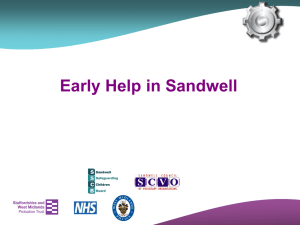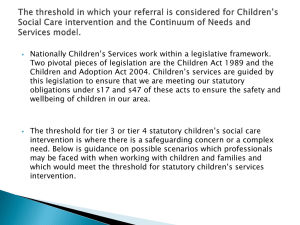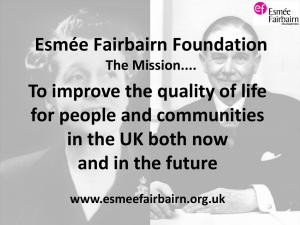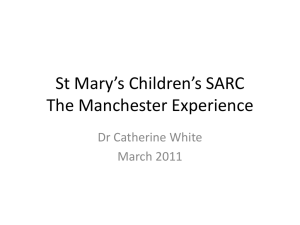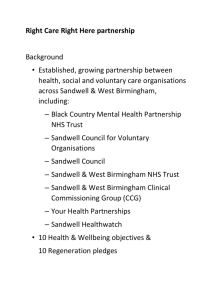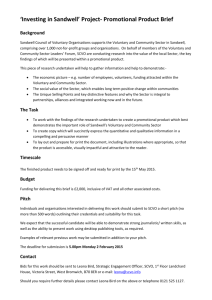MARF - Sandwell SCB
advertisement
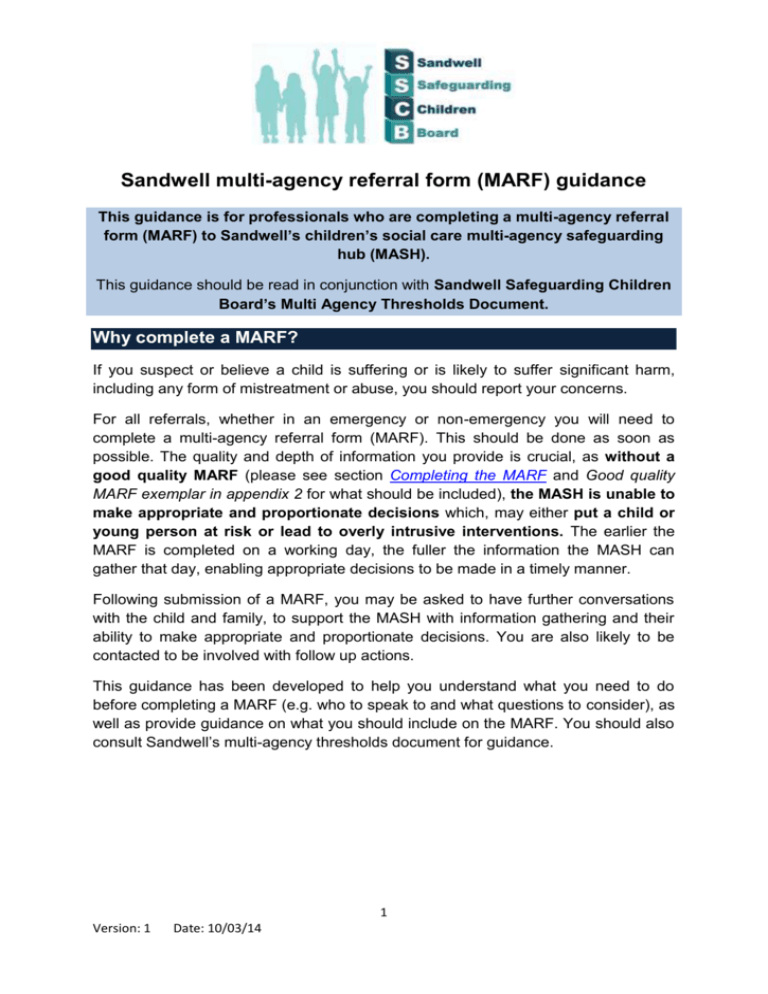
Sandwell multi-agency referral form (MARF) guidance This guidance is for professionals who are completing a multi-agency referral form (MARF) to Sandwell’s children’s social care multi-agency safeguarding hub (MASH). This guidance should be read in conjunction with Sandwell Safeguarding Children Board’s Multi Agency Thresholds Document. Why complete a MARF? If you suspect or believe a child is suffering or is likely to suffer significant harm, including any form of mistreatment or abuse, you should report your concerns. For all referrals, whether in an emergency or non-emergency you will need to complete a multi-agency referral form (MARF). This should be done as soon as possible. The quality and depth of information you provide is crucial, as without a good quality MARF (please see section Completing the MARF and Good quality MARF exemplar in appendix 2 for what should be included), the MASH is unable to make appropriate and proportionate decisions which, may either put a child or young person at risk or lead to overly intrusive interventions. The earlier the MARF is completed on a working day, the fuller the information the MASH can gather that day, enabling appropriate decisions to be made in a timely manner. Following submission of a MARF, you may be asked to have further conversations with the child and family, to support the MASH with information gathering and their ability to make appropriate and proportionate decisions. You are also likely to be contacted to be involved with follow up actions. This guidance has been developed to help you understand what you need to do before completing a MARF (e.g. who to speak to and what questions to consider), as well as provide guidance on what you should include on the MARF. You should also consult Sandwell’s multi-agency thresholds document for guidance. 1 Version: 1 Date: 10/03/14 The child is at risk of significant harm Emergency If a child is at imminent significant risk of harm/immediate danger (and reporting concerns cannot wait an hour while a MARF is completed), you should consider calling 999 in the first instance (for Police or an Ambulance) and contacting children’s social care by telephoning Sandwell's Contact Centre on 0121 569 3100 (out of office hours is the same number). You will also be expected to complete a MARF without delay. Non-Emergency If there is no immediate danger you should complete a MARF as soon as possible and within a maximum of 24 hours. You will not be required to telephone children’s social care to inform them of your referral. Send the MARF by secure email to access_team@sandwell.gcsx.gov.uk with the subject title MARF. (For those agencies who do not have secure email, please password protect the MARF before sending, and telephone Sandwell's Contact Centre to advise them of the password). Before you complete a MARF If you have concerns about a child or young person and would like to talk your concerns through with a professional, in the first instance contact your designated child protection lead from within your agency. For further advice and guidance contact your locality Early Help Social Worker. They will help you to determine the best course of action and can advise you on how to complete a MARF or Early Help Assessment. The role of the Early Help Social Workers and their contact details can be found in appendix 1. Before completing a MARF you should consider the following: Assessment Have I assessed the child and family and documented my findings? If not what is the source of my information? Evidence (see completing the MARF section for further guidance) What is happening, or not, which is causing concern/or impacting on the safety of the child? Is there any evidence of mental illness, substance abuse, domestic abuse, a chaotic lifestyle or missed appointments? 2 Version: 1 Date: 10/03/14 Actions Have I consulted my Local Safeguarding Children’s Board (LSCB) interagency procedures? How do the child’s needs meet Sandwell’s multi-agency thresholds for referral? Is an Early Help Assessment in existence for this child/ren? What are the existing risk factors or issues? Has the situation/referral been discussed with the child’s parent(s)/carers, or would this put the child at greater risk? Have I spoken with the child or young person about what has happened or happening? Are they aware of my concerns? Who else lives in/regularly visits the household? Do I have their personal details and know their relationship to the child/children? Has the situation been discussed with the child’s general practitioner and other relevant health professionals, e.g. adult mental health? Have I updated myself on the child and family’s recent history? Do I have knowledge of any siblings? May they be at risk of harm too? Is there a social worker already allocated? Have I discussed the referral with that social worker? I have discussed the situation with my safeguarding lead/ senior colleague from within my agency (as appropriate)? I am clear about my role with the family and what I have done to safeguard the child? Would an Early Help referral be more appropriate? Completing the MARF It is your responsibility as the referrer to provide clear, concise and relevant information on the referral form. This information should be based on but is not limited to: what you have witnessed; what you have learned from discussions with the child/young person; and discussions with their family. In the referral you should outline: what your concerns are and what needs to be improved why you think the child/young person is at risk of significant harm how you think the child/young person and family’s needs could be met and what outcomes are to be achieved All referrals must be legible and therefore we encourage referrers to type directly onto the MARF, but if this not possible please print clearly. Please return the MARF to access_team@sandwell.gcsx.gov.uk with the subject title MARF. 3 Version: 1 Date: 10/03/14 What to consider when completing the MARF 1. Child/young person’s details Family name/first name: State clearly the correct spelling of the child full name and any other name that the child is known by, or has been known by. DOB / Estimated Due Date: State the full date of birth of the child at the time of the referral. State whether the child has not yet been born and the estimated due date. Gender: Tick either Male, Female or Unborn Age: State the age of the child at the time of the referral (or where the child is unborn, the estimated due date). Please note that if the unborn child is less than 16 weeks gestation, the referral will not be accepted Ethnicity: To the best of your knowledge, select the ethnicity of the child from the list of available options. If the child’s ethnicity is not listed, and if known, please state it. This information may assist to identify services that meet the child’s ethnic background Religion: To the best of your knowledge, select the religion of the child from the list of available options. If the child’s religion is not listed, and if known, please state it. First Language: It is essential to identify the child’s first language. This information will ensure that Children’s Social Care is aware of any language needs when engaging and communicating with the child and family. Is an interpreter required? If the child’s first language is not English and an interpreter is not needed, please state clearly the reason why and who for (e.g. interpreter needed for parent but not child). NHS number: State, if known. Address, postcode, telephone number: State clearly the full home address of the child including the postcode and phone number. If the child is residing at more than one address or is residing away from their home address, please clearly state that address too. GP address and contact: Please state, if known. Nursery/school/children’s centre address and contact: Please state, if known. Physical characteristics: In order to identify the correct child/young person requiring the assessment, please include a description of the child’s characteristics: e.g. colour of eyes, hair, skin, approx. height and weight and any distinguishing marks. Child’s voice: Please state whether the child/young person is aware of the referral and whether their wishes are included. This will ensure that children’s social care staff are aware/not aware that the chid has been communicated with about the referral. 4 Version: 1 Date: 10/03/14 2. Details of referral Consider and answer (where appropriate) the following questions: What is the identified cause for concern? Is the child at risk of immediate harm? What is the impact (or potential impact) on the child/young person? How will the impact impair the child/young person's development? Does the child/young person still have contact with the person who caused them harm? Have you ever completed an Early Help Assessment for this child/young person? Is the child already subject to a child protection plan? What would be the impact if no timely action was taken i.e. what would the situation look like in four weeks time? Have you considered the impact of the child’s/family’s: age, disability, ethnicity, faith or belief, gender, gender identity, language, race and sexual orientation? Evidence/information your concern is based upon: Has the child made a disclosure? If the child/young person has a physical injury, describe clearly where the injury is, how the injury happened and the severity of the injury (i.e. bruising on the back of both arms, 4 small bruises on each arm, type of bruising suggests finger marks or being gripped). Did you witness the incident? Who did witness the incident? Provide their details. When did the incident take place? Date and time. Where did the incident take place? Be specific. Who was involved in the incident? Were any other siblings or children/young people present? If so who are they? What happened in the lead up to the incident? If no incident has taken place, provide specific details on the information your concerns are based upon. 3. Family context Outline your agency’s role/service provided to the child and or family. Confirm how long you have been involved; include a brief history of concerns and when you last saw the child/family. Outline your knowledge of the child’s needs and parent’s capacity to meet these. Include any family and environmental factors that impact on the child’s need and parent’s capacity. Provide details, and where known contact details of other professionals/agencies involved with the family . 5 Version: 1 Date: 10/03/14 4. Family composition and household members Please provide details of all other children in the household and adults who are known to live in the household e.g. step siblings, step father/mother, carers. Please state: name; gender; date of birth; relationship to subject child; school, nursery, children’s centre; and GP. This information should be completed to your fullest ability, as it significantly affects how effectively the MASH gathers information and assesses risk and causes a risk of duplicate records. 5. Significant others – not in household Please provide details of significant others who are not known to live in the household e.g. relatives, friends, ex partners of adults living in the household or others who have recently taken on caring responsibilities etc. Please state: name; gender; date of birth; relationship to subject child; whether they hold parental responsibility; and whether the person is known to pose a risk to children. Once again this information should be completed to your fullest ability, as it affects how effectively the MASH gathers information and assesses risk. 6. Consent and confidentiality Please state whether the parent is aware of the referral and whether they have provided consent. In the majority of cases parents should be made aware of the referral and consent sought. If the answer is no, please explain why. It is essential that professionals from universal services, early help and social care work in partnership with families and talk to them about their concerns, unless to do so would put the child and family at immediate risk of harm. Please state whether any of the information you have provided should not be shared with the subject child and family and why. As a result of MASH screening some referrals will have an outcome of Early Help. It is therefore important that you advise parents that support may be offered from early help services, rather than children’s social care. You will also need to discuss with parents the need for their consent for an early help outcome and gain this from them. Please be clear about your own role and the work that you have completed or are completing with the family to support them and their needs. Please be clear about the steps that you have taken within your role to safeguard the child/ren or young person. Please state your name, relationship to the person being referred, date, time, telephone number, agency, address and email. If you are not the person feedback should be provided to, please state the name and contact details for that person. 6 Version: 1 Date: 10/03/14 Appendix 1: Locality Early Help Social Workers Early Help Social Workers – role and contact details Sandwell has been re-shaping its children’s services offer to better meet the needs of children and families across Sandwell and ensure there is access to social work expertise by partners for cases that do not meet the threshold for social care assessment and support. To achieve this we are: Increasing the number of experienced family support workers in Early Help who can complete intensive direct work with children and families to support positive change Changing the role of the CAF Co-ordinators to enable them to provide greater support and coaching to partners working across universal and targeted services in the use of the CAF and in enhancing their ability to act as lead professionals (including the chairing of TAF meetings) Introducing a number of locality Social Workers in Early Help who will have strong links to safeguarding leads in schools, health and other universal and targeted services and who will be available for advice and support for more complex cases or queries arising from practitioners. Where there is an immediate risk of significant harm to children, it is important that practitioners continue to refer into the Multi-Agency Safeguarding Hub. For guidance on when to do so, see multi-agency thresholds document and MARF guidance. However, where there are risks or concerns relating to children that do not meet the child protection threshold, we must ensure we are using all available early help services to support children and families to meet their needs. Where practitioners have any doubts in this regard they should contact their early help locality social worker. The key roles of the early help social workers are: Carry a small caseload of complex Early Help cases, approximately 20 per year, that are on the border of social care threshold, where high level assessment, problem solving and decision making skills will be required Provide face to face support to safeguarding leads in localities on thresholds, complex cases and risk – acting as a key interface between ‘early help’ and social care 7 Version: 1 Date: 10/03/14 Be a ‘sounding board’ for partner agencies who require advice on referrals Provide advice and support and co work to allied practitioners within the service area i.e. Family Intervention Project, Family Intervention Project Light, Early Help Coordinators contributing to assessment of risk and decision making about thresholds of need and response where sufficient progress is not being made Attend COG meetings and contribute to problem resolution where cases are “stuck” Exercise advanced decision making in social work practice and be able to offer advice on a range of issues emerging within the COG area Provide expert consultancy to staff within their COG area in working with clients with complex needs in relation to substance misuse, mental health, learning disability and domestic violence Remain appraised of developments in practice and evidence based initiatives, ensure the dissemination of this learning and provide training within mainstream services on evidence based initiatives Early Help Social Workers – cover and contact details Social Worker Name Current vacancy Neelam Sharma Area covered Claire Mason West Bromwich – Rowley Smethwick Current Wednesbury vacancy Bimla Kumari Oldbury Bernadette Gorman Contact Details Tipton 0845 8673 Contact Details (e-mail) Please contact the Early Help main switchboard 0845 352 1841/2. 352 Neelam_Sharma@sandwell.gov.uk Claire_Mason@sandwell.gov.uk 0845 8643 0845 7131 0845 8647 352 Please contact the Early Help main switchboard 0845 352 1841/2. 352 Bimla_Kumari@sandwell.gov.uk 352 Bernadette_Gorman@sandwell.gov.uk 8 Version: 1 Date: 10/03/14 In the event that you are having difficulty in speaking to your designated Early Help social worker please contact the Early Help main switchboard 0845 352 1841/2. Appendix 2: Example of a good quality MARF Multi Agency Referral Form (MARF) This form should only be used to make a referral to Sandwell’s child protection Multi Agency Safeguarding Hub (MASH). If a child is at imminent significant risk of harm/immediate danger, you should consider calling 999 in the first instance (for Police or an Ambulance) and contacting children’s social care by telephoning Sandwell's Contact Centre on 0121 569 3100 (out of office hours is the same number). You will also be expected to complete a MARF without delay. If the child is in no immediate danger you must complete a MARF as soon as possible and within a maximum of 24 hours. Send the MARF by secure email to access_team@sandwell.gcsx.gov.uk with the subject title MARF (For those agencies who do not have secure email, please password protect the MARF before sending, and telephone Sandwell's Contact Centre to advise them of the password) For guidance on completing the MARF please see the accompanying Sandwell MARF Guidance and Multi Agency Thresholds documents 1. CHILD / YOUNG PERSON’S DETAI LS 9 Version: 1 Date: 10/03/14 Family Name Green First Name(s) Date of Birth/ 18 / 07 / 14 Gender Estimated Due Date Unborn Male Female Age 0 years, 0 months Ethnicity Please select by clicking here: Unborn If ‘Other’, please Religion Please select: If ‘Other’, Mixed ethnic group - White specify please specify and Black African First Language English Interpreter Y / N / Not Known required? Why/who for? NHS Number 123456789 Address 123 Alphabet Street Sandwell Metropolitan Borough Council B69 2AB Home Telephone No. 01213567891 GP Address/ Contact Dr Anon, Mobile No. 07776543210 Sandwell Medical Centre Sandwell Street Sandwell, B69 1AB Nursery/School/ N/A Children’s Centre Address/ Contact In order to identify the correct child / young person requiring the assessment, please include a 10 Version: 1 Date: 10/03/14 description of the child’s physical characteristics: e.g. Colour of Eyes, Hair, Skin, Approx Height/Weight and any distinguishing marks Child is unborn, therefore unable to provide a description. Child’s Voice Is the child or young person aware of the referral? Y / N / NK (Please provide an explanation) Have their wishes and feelings been included? Y / N / NK Child is unborn 2. DETAI LS OF REFERR AL Describe the identified cause for concern - what is the impact (or potential impact) on the child/ young person? Teyarna Green has disclosed that she is pregnant. Teyarna Green has a history with Children’s Services and has been subject to a child protection plan herself under the category of neglect. It is believed that this was in 2004. Maternal Grandmother was the victim of domestic abuse which Teyarna Green witnessed. Teyarna Green is currently in a relationship with John Jones, it is believed that this a violent relationship and that he has had children removed from a previous relationship. John Jones is known to the Police in relation to the domestic abuse incidents however Teyarna Green has reported that she has retracted the statements that she has made. Teyarna Green does not appear to acknowledge the impact her current relationship has on the unborn child. 11 Version: 1 Date: 10/03/14 During Teyarna Greens last appointment, at the Health Centre, she presented with a bruised eye and when asked how the injury was sustained she reported that she had walked into a door. There is a concern that Teyarna Green will remain in this violent relationship throughout the pregnancy. I have spoken with her regarding support from Sandwell Women’s Aid however she has declined stating that it is her intention to remain in the relationship with John Jones. There is a concern that should the violence continue the unborn child will be at risk of harm. On what evidence / information is your concern based? The evidence is based on conversations with Teyarna Green who has presented at the Health Centre with injuries. I am concerned that the injuries have been as a result of domestic incidents between the couple although I acknowledge that Teyarna Green has reported that the last injury was as a result of walking into a door. Teyarna Green has also disclosed that John Jones children, from a previous relationship, have involvement with Children’s Social Care due to the domestic abuse within that relationship. I have discussed support with Teyarna Roberts from Sandwell Women’s Aid but she has confirmed that she does not intend to end the relationship and would not consent to a referral being made to Sandwell Women’s Aid. There is also a concern that Teyarna Green has witnessed domestic abuse as a child and is now in an abusive relationship herself. 3. F AMILY CONTEXT Outline your agency’s role / service provided to the child and or family. Confirm how long you have been involved; include any history of concerns and when you last saw the child/ family I am the Community Midwife for Teyarna Green and met her during her booking appointment on the 7th January 2014. I have observed a change in her presentation from my original meeting five weeks ago. During the initial meeting Teyarna was well presented and was chatty and engaging however during the latest meeting John Jones also attended and I observed that she was more withdrawn, would not maintain eye contact and 12 Version: 1 Date: 10/03/14 appeared to look to John Jones for reassurance when being asked questions. Outline your knowledge of the child’s needs and parent’s capacity to meet these. Include any family and environmental factors that impact on child’s need and parent’s capacity. Teyarna Green is not acknowledging the concerns that her current circumstances may have upon the unborn child. I am concerned about the safety and welfare of the unborn child due to the current situation and her appearing not to accept support that has been offered. I have concerns regarding Teyarna's insight into the impact that domestic violence can have on her unborn child. I am also concerned regarding Teyarna's parenting capacity given her childhood experiences. In relation to John Jones I am aware that his children from a previous relationship have social care involvement therefore there may be concerns regarding his parenting capacity. Should Mother remain in this relationship I would have concerns regarding her ability to safeguard the child. Please provide details, and where known contact details, of other professionals/ agencies involved with the family None known. 4. F AMILY COMPOSI TION AND HOUSEHOLD MEMBERS Name Gender Teyarna Green M / F / NK DOB 01 / 10 / 91 (e.g. siblings/stepfather/carer) Relationship to School; Nursery; subject child Children’s Centre Mother Not Applicable GP Dr Anon Sandwell Medical Centre 13 Version: 1 Date: 10/03/14 4. F AMILY COMPOSI TION AND HOUSEHOLD MEMBERS John Jones M / F / NK 01 / 02 / 80 Father (e.g. siblings/stepfather/carer) Not Applicable Dr Anon Sandwell Medical Centre Joanne Green M / F / NK 01 / 01 / 7 Maternal Not Applicable Not Known Grandmother M / F / NK / / 5. SIGNIFIC ANT O THERS - NO T IN THE HOUSEHOLD Name Gender Date of Birth Relationship to subject child Julie Jones M / F / NK 6 / 9 / 11 Daughter of John Does this Is this person person hold known to pose a parental risk to children - responsibility? PPRC? Y / N / NK Y / N / NK Y / N / NK Y / N / NK Y / N / NK Y / N / NK Jones Paul Jones M / F / NK 8 / 5 / 08 Son of John Jones Susan Smith M / F / NK 1 / 4 / 79 Ex partner of John Jones 6. CONSENT & CONFI DENTI ALI TY Is the parent aware of the referral? Yes No Has the parent given consent to the referral being made? Yes No If the answer to either of the above is No please provide an explanation. It is essential that 14 Version: 1 Date: 10/03/14 professionals work in partnership with families and talk to them about their concerns, unless to do so would place a child or family at immediate risk of harm Mother has not provided consent but is aware that the referral has been made. Is any information contained in this referral to remain confidential from the subject child and family? If so, please outline specific information to remain confidential and reasons. NB details of referrer, if a professional person, cannot be held as confidential save in exceptional circumstances Not Applicable. Name of person completing referral Sara Smythe Relationship to child being referred Community Midwife Date 10.2.14 Time 16:38 hrs Tel No. 01215691234 Agency Community Midwife Sandwell Medical Centre Address Sandwell Medical Centre Sandwell Street Sandwell Metropolitan Borough Council B69 1AB Email s.smythe@sandwell.nhs.uk Name & contact details of person to whom feedback should be provided (if different to above) 15 Version: 1 Date: 10/03/14 Appendix 3: Example of a poor quality MARF Multi Agency Referral Form (MARF) This form should only be used to make a referral to Sandwell’s child protection Multi Agency Safeguarding Hub (MASH). If a child is at imminent significant risk of harm/immediate danger, you should consider calling 999 in the first instance (for Police or an Ambulance) and contacting children’s social care by telephoning Sandwell's Contact Centre on 0121 569 3100 (out of office hours is the same number). You will also be expected to complete a MARF without delay. If the child is in no immediate danger you must complete a MARF as soon as possible and within a maximum of 24 hours. Send the MARF by secure email to access_team@sandwell.gcsx.gov.uk with the subject title MARF (For those agencies who do not have secure email, please password protect the MARF before sending, and telephone Sandwell's Contact Centre to advise them of the password) For guidance on completing the MARF please see the accompanying Sandwell MARF Guidance and Multi Agency Thresholds documents 7. CHILD / YOUNG PERSON’S DETAI LS 16 Version: 1 Date: 10/03/14 Family Name BROWN First Name(s) Date of Birth/ 1 / 4 / 06 Gender Estimated Due Date CHARIE Male Female Age 7 years Ethnicity Please select by clicking here: Unborn If ‘Other’, please Religion Please select: If ‘Other’, White – specify please specify English/Welsh/Scottish First Language Interpreter required? Why/who for? NHS Number 67890123 Address 32b HOLLOWAY SANDWELL Home Telephone No. Mobile No. GP Address/ Contact Nursery/School/ Children’s Centre Gifted Children School Sandwell Address/ Contact 17 Version: 1 Date: 10/03/14 Y / N / Not Known In order to identify the correct child / young person requiring the assessment, please include a description of the child’s physical characteristics: e.g. Colour of Eyes, Hair, Skin, Approx Height/Weight and any distinguishing marks Short, white skinned Child’s Voice Is the child or young person aware of the referral? Y / N / NK (Please provide an explanation) Have their wishes and feelings been included? Y / N / NK 8. DETAI LS OF REFERR AL Describe the identified cause for concern - what is the impact (or potential impact) on the child/ young person? Carlie has become very quiet. She is usually bubbly and outgoing but appears withdrawn. 18 Version: 1 Date: 10/03/14 On what evidence / information is your concern based? Change in behaviour. 9. F AMILY CONTEXT Outline your agency’s role / service provided to the child and or family. Confirm how long you have been involved; include any history of concerns and when you last saw the child/ family School. Charlie has attended since 2002 last seen today. Outline your knowledge of the child’s needs and parent’s capacity to meet these. Include any family and environmental factors that impact on child’s need and parent’s capacity. Mother is abrupt. We do not have many dealings with Mother. Please provide details, and where known contact details, of other professionals/ agencies involved with the family 19 Version: 1 Date: 10/03/14 10. F AMILY COMPOSI TION AND HOUSEHOLD MEMBERS (e.g. siblings/stepfather/carer) Name Gender Jasmine Brown DOB M / F / NK / / M / F / NK / / M / F / NK / / M / F / NK / / 11. Relationship to School; Nursery; subject child Children’s Centre GP Mother SIGNIFIC ANT O THERS - NO T IN THE HOUSEHOLD Name Gender Date of Birth Relationship to subject child 20 Version: 1 Date: 10/03/14 Does this Is this person person hold known to pose a parental risk to children - responsibility? PPRC? M / F / NK / / Y / N / NK Y / N / NK M / F / NK / / Y / N / NK Y / N / NK M / F / NK / / Y / N / NK Y / N / NK 12. CONSENT & CONFI DENTI ALI TY Is the parent aware of the referral? Yes No Has the parent given consent to the referral being made? Yes No If the answer to either of the above is No please provide an explanation. It is essential that professionals work in partnership with families and talk to them about their concerns, unless to do so would place a child or family at immediate risk of harm Is any information contained in this referral to remain confidential from the subject child and family? If so, please outline specific information to remain confidential and reasons. NB details of referrer, if a professional person, cannot be held as confidential save in exceptional circumstances Name of person completing referral SHERVONNE HAMILTON Relationship to child being referred TEACHER Date 10.2.14 Time 21 Version: 1 Date: 10/03/14 Tel No. 01213031234 Address GIFTED CHILDREN SCHOOL Agency SANDWELL Email Name & contact details of person to whom feedback should be provided (if different to above) 22 Version: 1 Date: 10/03/14
